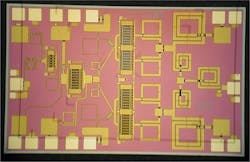DARPA eyes monolithic-scale electro-magnetic components for military RF and microwave systems
ARLINGTON, Va., 17 June 2016. U.S. military researchers are trying to do for magnetic components what they've done for monolithic microwave integrated circuits (MMICs) -- develop them on semiconductor substrates to reduce their size and enable new functionality for military RF and microwave systems.
Officials of the U.S. Defense Advanced Research Projects Agency (DARPA) in Arlington, Va., issued a broad agency announcement on Thursday (DARPA-BAA-16-36) for the Magnetic Miniaturized and Monolithically Integrated Components (M3IC) project.
M3IC seeks to push the state of the art in manufacturing magnetic components crucial for military RF and microwave systems like radio communications, electronic warfare (EW), signals intelligence (SIGINT), and unmanned vehicle navigation and guidance.
Magnetic components are critical to the performance and operation of DOD RF and microwave systems, yet they cannot be manufactured with the same level of tight integration of today's latest MMICs and sophisticated digital integrated circuits, DARPA researchers say.
Related: Air Force awards nine contracts to build advanced components for electronic warfare
Today's RF and microwave transmit and receive (T/R) modules, for example, are assembled with MMICs and large off-chip magnetic components such as circulators, isolators, and inductors, which use magnetic materials for size, weight, and functionality not available in electronic components.
Circulators in T/R modules use magnetic materials to control the flow of electrical signals between the antenna terminal, transmit power amplifier, and receiver low-noise amplifier.
Still, the high packing densities achievable on MMICs -- the result of decades of investment in scalability and integration of transistors, resistors, and capacitors on semiconductor chips -- are not achievable with current magnetic components.
As such, critical magnetic components must be assembled off-chip, which adversely affects cost, size, weight, and power (C-SWaP) and constrains RF system design, researchers say. The DARPA M3IC project is trying to change all that.
Related: Plextek RFIC designers choose simulation software from Agilent to fine-tune circuit designs
From industry, experts at the DARPA Microsystems Technology Office would like proposals that center on integrating magnetic components on semiconductor substrates; modeling system-level effects of nonlinear, non-reciprocal, time-dependent magnetic phenomena; and optimizing miniaturized microwave magnetic components.
The M3IC project revolves around three technical challenges:
-- growing and patterning high-quality, uniform, thick, and temperature-stable magnetic films on standard semiconductor substrates while preserving the properties of the magnetic material and the semiconductor circuitry;
-- capturing nonlinear, non-reciprocal, and time-varying behavior at the micro-scale, and translating that behavior into its system-level impact; and
-- exploring ways to control and optimize the interaction between the electro-magnetic fields and magnetic materials with new design tools and improvements in integrated magnetic materials to deliver new and improved functionality and performance in small form factors.
Related: First came VHSIC, then came MIMIC, and now comes ACE to push electronics technology
The ultimate goal of the M3IC program is to find new ways for the seamless co-design of integrated magnetic materials and semiconductors that will enable reduced size, increased bandwidth, and improved stability and power efficiency in electro-magnetic components in military RF and microwave systems.
DARPA officials say they plan to award several M3IC contracts and spend as much as $26 million over the entire project. Companies interested should submit proposals no later than 1 Aug. 2016 to the DARPA BAA Website at https://baa.darpa.mil.
Email questions or concerns to DARPA's William Palmer at [email protected]. More information is online at https://www.fbo.gov/spg/ODA/DARPA/CMO/DARPA-BAA-16-36/listing.html.

